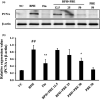Effects of larval extracts from identified Protaetia brevitarsis seulensis against benign prostatic hyperplasia induced by testosterone in rats
- PMID: 34646508
- PMCID: PMC8498080
- DOI: 10.1002/fsn3.2460
Effects of larval extracts from identified Protaetia brevitarsis seulensis against benign prostatic hyperplasia induced by testosterone in rats
Abstract
Protaetia brevitarsis seulensis is an animal-based medicine used traditionally in China, Japan, and Korea to treat hepatic disorders; it has been shown to possess various pharmacological effects such as antibacterial and antioxidant activities. In this study, we investigated the effects of P. brevitarsis on a testosterone-induced benign prostatic hyperplasia (BPH) rat model. To establish the BPH model, the animals were administered a subcutaneous injection of testosterone daily for 28 days. P. brevitarsis was administered by oral gavage at doses of 12.5, 25, and 50 mg/kg for 28 days, along with testosterone injection. P. brevitarsis treatment markedly decreased the absolute and relative prostate weight of BPH animals. The levels of dihydrotestosterone was reduced in P. brevitarsis-treated animals compared to those in the BPH animals. Histological analysis of the prostate showed that P. brevitarsis treatment effectively suppressed the testosterone-induced hyperplasia of prostatic epithelial cells, which was accompanied by reductions in the PCNA and Ki-67 expressions in prostatic tissues. These results indicate that P. brevitarsis effectively suppresses testosterone-induced development of BPH, and thus, is a potential therapeutic agent for BPH.
Keywords: Protaetia brevitarsis seulensison; benign prostatic hyperplasia; dihydrotestosterone; testosterone.
© 2021 The Authors. Food Science & Nutrition published by Wiley Periodicals LLC.
Conflict of interest statement
The authors declare that they do not have any conflict of interest.
Figures






References
LinkOut - more resources
Full Text Sources
Other Literature Sources
Miscellaneous

